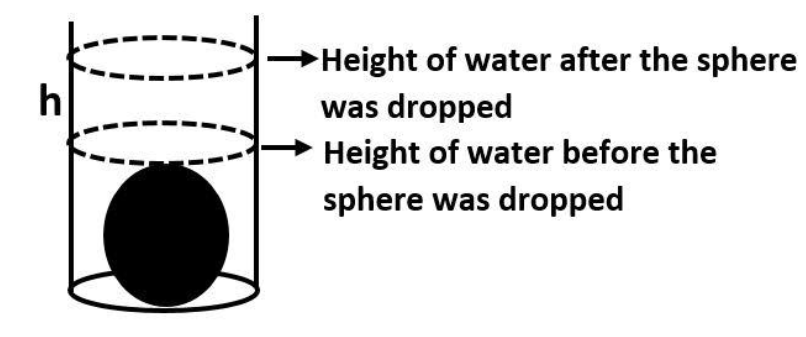
A sphere of diameter $6\,cm$ is dropped in a right circular cylindrical vessel partly filled with water. The diameter of the cylindrical vessel is $13\,cm.$If the sphere is completely submerged in water, by how much will the level of water rise in the cylindrical vessel.
Answer
564.3k+ views
Hint: The volume of the sphere will be equal to the volume of the water that raised from the original height that the cylinder had, before dropping the sphere. Compare the volume of the raised water with the volume of the sphere to solve the question.
Complete Step by Step Solution:
It is given to us that,
The sphere has diameter, $d = 6\,cm$
Thus the radius of the cylinder is $r = 3\,cm$
The diameter of right circular cylindrical vessel is $D = 13\,cm.$
Thus the radius of the circular cylindrical vessel is $R = \dfrac{{13}}{2}\,cm$
Observe the diagram

Let the height of the rise in water level be $'h'.$
Now, we can observe that the volume of water that will rise from its initial level will be equal to the volume of the sphere.
Therefore, ${V_c} = {V_s}$ . . . (1)
Where,
${V_c}$ is the volume of the water level raised.
${V_s}$ is the volume of the sphere.
Now, we know that,
${V_c} = \pi {R^2}h$ and ${V_s} = \dfrac{4}{3}\pi {r^3}$
Therefore, from equation (1), we get
$\Rightarrow \pi {R^2}h = \dfrac{4}{3}\pi {r^3}$
Substitute the given values in the above equation. We get
$\Rightarrow {\left( {\dfrac{{13}}{2}} \right)^2} \times h = \dfrac{4}{3} \times {(3)^3}$
By simplifying it, we get
$\Rightarrow \dfrac{{13 \times 13}}{4} \times h = \dfrac{4}{3} \times 3 \times 3 \times 3$
$\Rightarrow h = \dfrac{{4 \times 3 \times 3 \times 3 \times 4}}{{13 \times 13}}$
$\Rightarrow h = \dfrac{{144}}{{169}} = 0.83$
Therefore, the rise in water level will be $0.83\,cm$
Note:
In this question, you need to understand that the water level of the cylindrical vessel will rise. And that the volume of the raised water will be equal to the volume of the cylinder. Without understanding this reasoning, you will never be able to solve this question. But once you understand this, then this question is a simple question of substituting values in the formula, and to get the answer.
Complete Step by Step Solution:
It is given to us that,
The sphere has diameter, $d = 6\,cm$
Thus the radius of the cylinder is $r = 3\,cm$
The diameter of right circular cylindrical vessel is $D = 13\,cm.$
Thus the radius of the circular cylindrical vessel is $R = \dfrac{{13}}{2}\,cm$
Observe the diagram

Let the height of the rise in water level be $'h'.$
Now, we can observe that the volume of water that will rise from its initial level will be equal to the volume of the sphere.
Therefore, ${V_c} = {V_s}$ . . . (1)
Where,
${V_c}$ is the volume of the water level raised.
${V_s}$ is the volume of the sphere.
Now, we know that,
${V_c} = \pi {R^2}h$ and ${V_s} = \dfrac{4}{3}\pi {r^3}$
Therefore, from equation (1), we get
$\Rightarrow \pi {R^2}h = \dfrac{4}{3}\pi {r^3}$
Substitute the given values in the above equation. We get
$\Rightarrow {\left( {\dfrac{{13}}{2}} \right)^2} \times h = \dfrac{4}{3} \times {(3)^3}$
By simplifying it, we get
$\Rightarrow \dfrac{{13 \times 13}}{4} \times h = \dfrac{4}{3} \times 3 \times 3 \times 3$
$\Rightarrow h = \dfrac{{4 \times 3 \times 3 \times 3 \times 4}}{{13 \times 13}}$
$\Rightarrow h = \dfrac{{144}}{{169}} = 0.83$
Therefore, the rise in water level will be $0.83\,cm$
Note:
In this question, you need to understand that the water level of the cylindrical vessel will rise. And that the volume of the raised water will be equal to the volume of the cylinder. Without understanding this reasoning, you will never be able to solve this question. But once you understand this, then this question is a simple question of substituting values in the formula, and to get the answer.
Recently Updated Pages
Master Class 10 General Knowledge: Engaging Questions & Answers for Success

Master Class 10 Computer Science: Engaging Questions & Answers for Success

Master Class 10 English: Engaging Questions & Answers for Success

Master Class 10 Social Science: Engaging Questions & Answers for Success

Master Class 10 Maths: Engaging Questions & Answers for Success

Master Class 10 Science: Engaging Questions & Answers for Success

Trending doubts
The shortest day of the year in India

Why is there a time difference of about 5 hours between class 10 social science CBSE

Write a letter to the principal requesting him to grant class 10 english CBSE

What is the median of the first 10 natural numbers class 10 maths CBSE

The Equation xxx + 2 is Satisfied when x is Equal to Class 10 Maths

Which of the following does not have a fundamental class 10 physics CBSE




